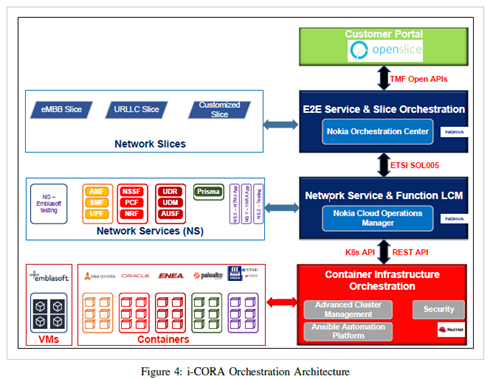
i-CORA – leading the way in developing and testing 5G SA services and uses cases in Europe
i-CORA – leading the way in developing and testing 5G SA services and uses cases in Europe
i-CORA (Innovative, Cloud-native, Open, Robust, and Automated) is a large scale multivendor, cloud native experimentation and testing platform for new 5G services for European operators, service providers, and enterprises. Emblasoft Evolver provides testing, validation, and active monitoring for the project.
To meet the highest performance requirements demanded by different vertical use cases in 5G, it is essential to develop and build large-scale experimentation platforms to test and validate services and network slices throughout their entire lifecycle. One such platform, i-CORA (Innovative, Cloud-native, Open, Robust, and Automated), has been built by multiple vendors to support the research and innovation demands from EU projects, vertical use cases, and mobile operators’ business areas.
i-CORA architecture
The i-CORA platform serves EU projects such as 5G- SOLUTIONS, FUDGE-5G, 5G-HEART, 5GMediaHUB1, FIDAL2, COMMECT4, IMAGINE-B5G, and 5G-EMERGE5. It consists of four parts: a main multi-vendor platform (MVP) offering an E2E public 5G network; a set of Mobile Private Networks (MPNs); a set of Networks on Wheels (NOWs); and an Open-Source Platform (OSP). The i-CORA architecture is shown below in Figure 1[1].

The platform is a multi-vendor, cloud native environment (to represent real-world 5G networks) from both near-commercial and open-source solutions provided by more than a dozen partners. It offers end-to-end (E2E) 5G services across multiple locations in Norway, and interconnects with other experimental European platforms, for example platforms in Greece and Spain, to support different EU-funded projects and different vertical use cases.
It is also equipped with a full- stack management and orchestration (MANO) system and able to automate the lifecycle management of network services and vertical applications. It also isolates, using separate infrastructures, General Use Cases (to validate the vertical applications and/or KPIs, which require a reliable testbed for fundamental 5G services) and Vertical Use Cases (which require flexible and open testing environments to validate advanced and innovative technologies). Verticals supported include PPDR (Public Protection and Disaster Relief), Healthcare, Industry 4.0, Media, Agriculture, Aquaculture, and Forestry, to name a few.
Multivendor E2E 5G SA core network
The platform consists of four parts: a multi-vendor end-to-end 5G core network with three RAN sites serving general use cases; two mobile private networks (MPNs); three Networks on Wheels (NOWs) serving dedicated verticals: and an open-source platform (OSP). It enables four main services:
- 5G Network Slicing Services
- Automation
- Testing and Validation
- Use Cases
Of course, testing has different, demanding requirements from different stakeholders:
- To test integration and performance (operators)
- Validate new technologies and services (solution and service providers)
- Validate service KPIs (vertical customers)
The overall architecture can be seen in the diagram below (reproduced from the paper).

For operators, test and validation is crucial. That’s where Emblasoft comes in. Previously, Emblasoft worked with Telenor and eight other vendors – leading enterprise service providers – Casa Systems, Emblasoft, ENEA, Huawei, Kaloom, Oracle, Palo Alto Networks, and Red Hat – to provide end-to-end functionality tests, automated node testing, active service monitoring, and load testing. In addition, Emblasoft was tasked with validating the different network slices to support multiple vertical use cases.
The crucial role of Emblasoft Evolver
Similarly, Emblasoft Evolver is being used by i-CORA to test and validate the 5G SA core network (CN) and explore the SBA – the CN is deployed at Telenor headquarters in Fornebu, Norway, and is jointly supplied by three vendors: CASA systems, ENEA, and Oracle.
For operators, Evolver uses synthetic traffic to help test the packet performance of the network, and other parameters, in order to test KPIs and to help troubleshoot, while for service providers Evolver’s simulated components test interoperability when a new CNF is introduced.
For example, i-CORA will use Evolver to test SEPP-based roaming scenarios by simulating the gNB and roaming UEs. It’s also being used to ensure KPIs and SLAs are met for vertical customers, while its active monitoring component is deployed in the i-CORA infrastructure to validate the performance of various components and services. Of course, testing with Emblasoft Evolver is flexible, highly scalable, and automated.
The full details of i-CORA were presented by Telenor at the IEEE Global Communications (GlobeCom) Conference, held in Kuala Lumpur, Malaysia on 4–8 December 2023. If you would like to read the full paper, you can download it, here.
If you would like to know how Emblasoft can help you test and validate your 5G and 4G networks, services, and slices at scale with full automation, get in touch today.
[1] Figures reproduced are copyright IEEE:
© 2023 IEEE. Personal use of this material is permitted. Permission from IEEE must be obtained for all other uses, in any current or future media, including reprinting/republishing this material for advertising or promotional purposes, creating new collective works, for resale or redistribution to servers or lists, or reuse of any copyrighted component of this work in other works